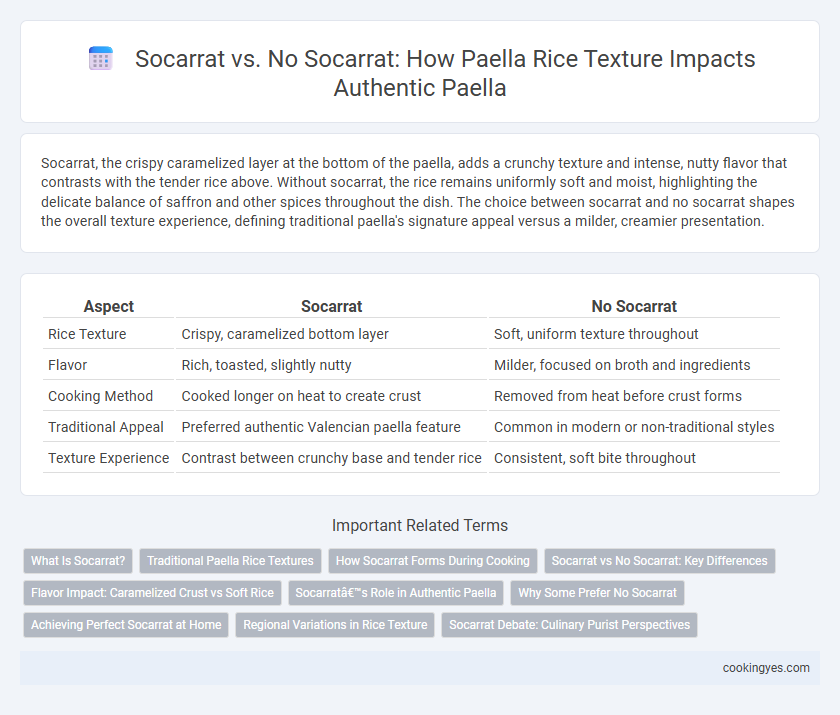Socarrat, the crispy caramelized layer at the bottom of the paella, adds a crunchy texture and intense, nutty flavor that contrasts with the tender rice above. Without socarrat, the rice remains uniformly soft and moist, highlighting the delicate balance of saffron and other spices throughout the dish. The choice between socarrat and no socarrat shapes the overall texture experience, defining traditional paella's signature appeal versus a milder, creamier presentation.
Table of Comparison
| Aspect | Socarrat | No Socarrat |
|---|---|---|
| Rice Texture | Crispy, caramelized bottom layer | Soft, uniform texture throughout |
| Flavor | Rich, toasted, slightly nutty | Milder, focused on broth and ingredients |
| Cooking Method | Cooked longer on heat to create crust | Removed from heat before crust forms |
| Traditional Appeal | Preferred authentic Valencian paella feature | Common in modern or non-traditional styles |
| Texture Experience | Contrast between crunchy base and tender rice | Consistent, soft bite throughout |
What Is Socarrat?
Socarrat refers to the crispy, caramelized layer of rice at the bottom of a traditional paella pan, prized for its nutty flavor and crunchy texture. Achieving socarrat requires careful control of heat to toast the rice without burning, creating a desirable contrast to the tender grains above. Paella enthusiasts debate the balance between socarrat and no socarrat, as some prefer uniformly soft rice, but socarrat remains a hallmark of authentic paella cooking.
Traditional Paella Rice Textures
Traditional paella achieves its signature texture through the contrast between socarrat, a crispy caramelized layer formed at the bottom of the pan, and the tender, moist rice above it. Socarrat results from cooking the rice without stirring, allowing slight toasting and Maillard reaction to develop deep, nutty flavors essential to authentic Valencian paella. Without socarrat, the rice remains uniformly soft but lacks the complex texture and flavor depth highly prized in traditional paella preparations.
How Socarrat Forms During Cooking
Socarrat forms during paella cooking when the rice at the bottom of the pan caramelizes and crisps due to direct contact with high heat and limited liquid absorption. The Maillard reaction develops this prized crunchy layer, creating a contrast in texture with the tender, steamed rice above. Proper heat management and even liquid evaporation are crucial to achieving the perfect socarrat without burning the rice.
Socarrat vs No Socarrat: Key Differences
Socarrat is the prized crispy, caramelized layer of rice at the bottom of a paella, offering a crunchy texture and rich, nutty flavor that contrasts with the tender, moist grains above. No socarrat results in uniformly soft rice, lacking the distinctive crunch and intensified taste that socarrat imparts. The presence of socarrat is often considered a hallmark of authentic paella, highlighting expert cooking technique and contributing to a complex sensory experience.
Flavor Impact: Caramelized Crust vs Soft Rice
The socarrat in paella creates a caramelized crust that adds a rich, nutty flavor and a slight crunch, enhancing the overall taste complexity. In contrast, paella without socarrat features soft rice that absorbs the broth fully, resulting in a creamier and more uniform flavor profile. This distinction between socarrat and soft rice significantly impacts the texture and flavor experience of traditional paella.
Socarrat’s Role in Authentic Paella
Socarrat refers to the crispy, caramelized layer of rice formed at the bottom of a traditional paella, prized for its intense flavor and crunchy texture. Achieving the perfect socarrat requires precise control of heat and cooking time, distinguishing authentic paella from versions lacking this signature crust. While some prefer no socarrat for a softer texture, the presence of socarrat is a defining characteristic that enhances the complexity and authenticity of paella rice.
Why Some Prefer No Socarrat
Some prefer no socarrat in paella because it results in a uniformly tender and moist rice texture, avoiding the crisp, caramelized bottom layer that can be somewhat crunchy or slightly bitter. This preference caters to diners who favor softer grains and a milder flavor profile without the toasted notes from the socarrat. Paella without socarrat allows the saffron and broth flavors to permeate evenly, creating a more consistent taste throughout the dish.
Achieving Perfect Socarrat at Home
Achieving the perfect socarrat--the crispy, golden crust at the bottom of a paella--is essential for authentic rice texture and flavor. Use a wide, shallow paella pan over medium-high heat to allow even browning without burning, and avoid stirring the rice once the liquid has been absorbed to let the crust form naturally. Controlling heat and timing ensures the socarrat develops with a satisfying crunch, contrasting the tender, moist rice above, distinguishing traditional paella from softer, less textured versions without socarrat.
Regional Variations in Rice Texture
The Socarrat, a crispy caramelized rice layer at the bottom of the pan, is a prized feature of Valencian paella, symbolizing authenticity and expert cooking technique. In contrast, regions like Catalonia often serve paella with a softer, moister rice texture, emphasizing creaminess over crunch. These regional variations reflect local preferences and influence the paella's flavor profile and mouthfeel, showcasing Spain's diverse culinary heritage.
Socarrat Debate: Culinary Purist Perspectives
The Socarrat debate centers on whether the coveted crispy rice layer at the bottom of paella is essential for authentic texture and flavor or if a uniform, tender rice consistency suffices. Culinary purists argue that achieving Socarrat is crucial for true Valencian paella, as the caramelized rice adds a unique crunch and depth missing in non-Socarrat versions. Opponents believe that overemphasis on Socarrat risks burning the dish and prefer a balanced, moist rice texture emphasizing the harmony of ingredients.
Socarrat vs No Socarrat for Paella rice texture Infographic

 cookingyes.com
cookingyes.com